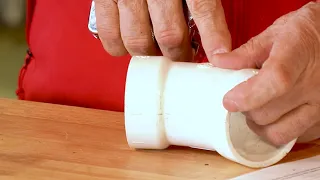In Installing The BEST Plumbing Water Filtration System, we dive into how a one-tank filtration and conditioning unit can transform the water quality in your home. Having safe, great-tasting water isn’t just about convenience; it can significantly impact your health, the longevity of your plumbing fixtures, and even the flavor of your cooking. If you’ve ever smelled chlorine each time you turned on the tap, or dealt with hard water staining and scale buildup, you’ll appreciate how a properly installed filtration and treatment unit can solve these issues once and for all.
Why a Whole-House Water Filtration System Matters
Chlorine is often added to municipal water to ensure it arrives at your home free of bacteria, mold, or other harmful organisms. While that’s a necessary part of water treatment, high chlorine levels can be harsh on hair, skin, clothing, and appliances. On top of that, many water sources have varying pH levels, and water that’s too alkaline or acidic can damage metal fixtures and piping over time.
A properly designed whole-house filtration system handles multiple water quality concerns:
- Removes or significantly reduces chlorine so the water tastes, smells, and feels better
- Adjusts pH to more balanced levels so that water won’t corrode or damage plumbing components
- Traps sediment and debris, preventing buildup in water heaters, faucets, and showerheads
The best part is that you don’t have to guess about what’s in your water. Simple at-home test kits or references to a third-party testing organization (such as ewg.org) can give you clear insight into potential contaminants in your area. Once you know what’s in your water, you can decide if a filtration and conditioning unit is right for you.
Initial Water Testing
Before diving into the system installation, it’s essential to test your existing water quality. Many plumbers or homeowners use basic test kits with reagents to check:
- Chlorine levels
- pH balance
- Presence of metals, minerals, or other elements
In the demonstration, the water from the tap had a chlorine reading around 3.0 parts per million (ppm). For context, swimming pools often maintain a range of 1 to 3 ppm chlorine. If your drinking water is hovering around that same amount, you might notice the distinctive chlorine smell—or even taste—in every sip.
A pH test can reveal if your water is too acidic (below 7.0) or too alkaline (above 7.5). In this case, the water tested was somewhere between 7.8 and 8.2. While that’s generally not as alarming as highly acidic water, it can still mean your water is on the higher end of the pH scale, which may cause scale deposits.
Having this data ensures you choose a system that tackles the specific issues in your water supply.
Key Features of This One-Tank System
One reason this particular one-tank system (like the Halo H2O) stands out is that it provides both filtration and conditioning in a single tank. Traditional setups might require two or more separate tanks, a backwash system, and electrical connections for the control valve. This Halo system, however, is streamlined:
- No drain connection required because there’s no backwashing
- No electricity needed, simplifying installation
- Filtration media and water conditioning happen in the same tank
- Comes with a sediment guard (final polishing filter) to trap any tiny particles that make it past the main tank
Additionally, the unit typically has a 10-year warranty, which gives homeowners peace of mind. If you’re a professional plumber, that warranty can be a huge selling point, reassuring customers they’re investing in a long-term solution rather than a short-term fix.
Digging and Positioning the Filtration Tank
Installing an outdoor or in-ground water filtration system can involve a good bit of excavation—especially if you want it entirely below the frost line or out of sight. Here’s an overview of the main steps:
- Choose a Proper Location
If you have polybutylene or older plumbing lines, decide whether to replace them or safely tie into them without risking leaks. Ideally, your filtration tank will sit close to where the main water line enters the property. - Excavate the Area
Dig a hole that comfortably accommodates the filtration tank. The hole should be deep enough so that the top of the tank, plumbing fittings, and bypass valves can be accessed once you’re finished. - Dry-Fit the Tank
Place the tank into the hole to see how it sits. You’ll need to plan where the incoming (unfiltered) line and outgoing (filtered) line connect to the top of the tank. Double-check the space for any additional valves or fittings. - Create a Bypass Setup
A three-valve bypass is invaluable. It allows you to shut off water to the filtration system while still providing city water to the house. This setup is extremely handy for maintenance because you won’t have to deprive the entire home of water service during repairs.
Building the Three-Valve Bypass
Having a dedicated bypass makes the system easier to maintain and prevents lengthy water shutoffs in the future. The typical layout is:
- One valve on the unfiltered line heading into the unit
- One valve on the filtered line exiting the unit
- A middle valve bridging the unfiltered and filtered line, letting you send water straight to the house if the filtration tank is offline
Check local plumbing codes for any additional requirements or backflow prevention devices.
Pre-Soaking the Carbon Media
Unlike small under-sink filters, whole-house units use a bed of carbon and conditioning media that should be fully saturated before you begin final flushing. Carbon soaking can be done in two ways:
- Pre-filling the tank in a garage or nearby area before setting it in the hole
- Installing the tank first, then slowly filling it with water to allow the media to soak in place
In the video, the installers placed the tank in the hole first (to keep it light and maneuverable) and then let water in, allowing the carbon bed to soak for at least 48 hours. Extended soaking (like 10+ days) is not a problem if you need to delay final flushing.
Final Flushing and System Startup
After your media has soaked, the next step is to flush out any remaining carbon fines—tiny powder-like particles. This prevents them from clogging faucets or showing up as black specks in your bathtub. Here’s how to do it:
- Attach a Hose to the Filter Outlet
Position a garden hose on the filter’s flush-out port or top valve, directing water away from the foundation. - Slowly Open the Valve
Let water run gently at first so you don’t stir up a thick cloud of carbon. Continue flushing until the water starts to clear. - Short Bursts and Resealing
Close the valve to build pressure, then reopen it to let water rush through again. Do this repeatedly to dislodge any stubborn particles. Each flush might last around five minutes. - Inspect the Discharged Water
If you see tiny black flecks or grayish discoloration, keep flushing. You want water coming out clear before continuing. - Integrate the Sediment Filter
Many systems include a final “polishing” filter after the main carbon tank to catch very fine particles. Make sure to add this step to your plumbing.
Water Testing After Installation
Once the system is flushed and water flows clearly, run an outside faucet or bathtub to clear any trapped air in the lines. Then, re-test your water:
- Chlorine Levels
You should see a notable reduction or nearly no chlorine present compared to your initial reading. - pH Balance
Confirm it’s closer to a balanced range. While some filtration systems raise pH slightly, that’s generally considered a benefit since many bottled alkaline waters are sold at a premium.
A well-installed system will typically reduce chlorine to a very low level and keep your pH in an ideal range. That leads to softer-feeling water, reduced scale, and no more chlorine smell or taste.
Maintenance and Filter Changes
One of the benefits of a no-backwash, no-electricity system is lower upkeep. However, you should still:
- Change the sediment guard filter periodically (often once or twice a year, depending on usage and water quality)
- Inspect the bypass valves and fittings annually to ensure no leaks
- Note any changes in water pressure or taste, as that could signal a need for a carbon media refresh (though that’s not usually necessary for many years)
For homeowners, this is a straightforward process. If you prefer professional help, schedule annual check-ups with a plumber who can quickly swap out filters, confirm water flow, and ensure the carbon media still performs optimally.
Elevating Your Home’s Water Quality
Installing The BEST Plumbing Water Filtration System can bring multiple advantages:
- Better-tasting water with little to no chlorine odor
- Improved feel on skin and hair, especially if you’ve experienced dryness or irritation
- Less wear on appliances, often extending the life of water heaters, dishwashers, and washing machines
- Fewer mineral stains on sinks, toilets, and showers
- Greater peace of mind, knowing your water is clean, balanced, and safe
If you have high chlorine levels, sediment issues, or a pH outside the recommended range, a whole-house filtration and conditioning system can be the solution you’ve been searching for.
Find Out More
This filtration system is provided by Halo, a company dedicated to giving plumbers and homeowners an efficient, low-maintenance approach to water conditioning. With its 10-year warranty and all-in-one design, it’s perfect for homeowners who lack a pre-existing drain line or the space for multiple tanks.
If you want cleaner water or seek a way to enhance your plumbing business with water conditioning services, visit halowater.com. Explore the product line, check out installation guidelines, and see how a system can be customized for your specific water issues.
Conclusion
Installing The BEST Plumbing Water Filtration System can transform the quality of life in your home. By removing chlorine, balancing pH, and preventing sediment from circulating through your pipes, you’re protecting both your family’s health and your plumbing investment. The process starts with a simple water test, leads to a thoughtful installation that includes a three-valve bypass, and finishes with final flushing and testing. Whether you’re a plumber looking to improve your services or a homeowner seeking the right filtration solution, a high-quality one-tank system offers an easy-to-install, robust option that stands the test of time.




